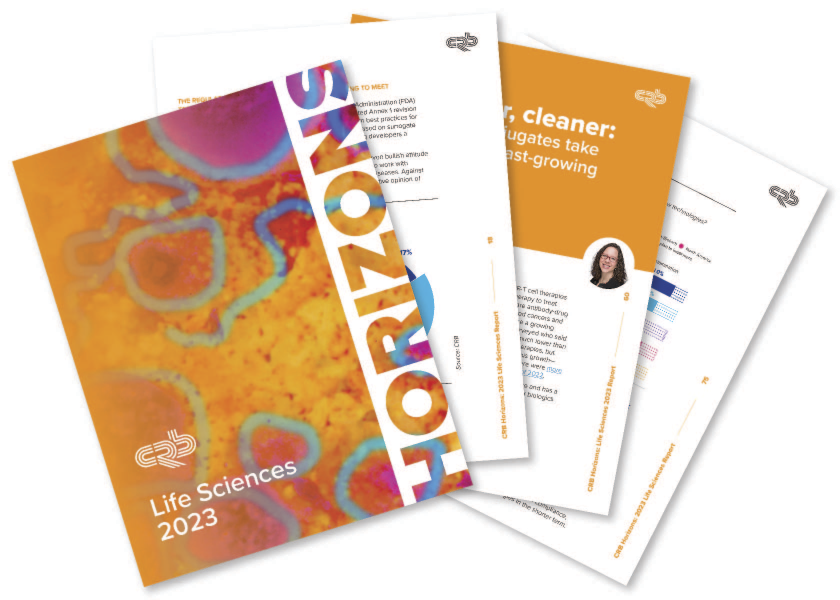
This report, the fourth in our Horizons: Life Sciences series, tests this vision of improved patient access. We draw on the perspective of more than 500 small, medium and large companies operating across North America and Europe to examine each submarket in detail, looking closely at the milestones that brought them to this moment and the trends that are shaping their future—trends that will determine how quickly the next revolution in life-changing medicine will unfold.
At a time when the life science industry is producing one first-in-class therapy after another, allow me to make what I’m sure is a first-in-class statement: Jurassic Park has something to teach us about life-saving medicine.
Sure, there’s the obvious bit where an animated double-helix explains dino DNA. Now thirty years old, that scene still holds up—in fact, we could find ourselves once more on the brink of sharing this planet with the woolly mammoth, thanks to the landmark de-extinction research underway at Colossal Laboratories & Biosciences. There may not be fossilized mosquitos involved (sorry, Mr. DNA Sequence), but today’s scientific advances are making Jurassic Park’s impossible premise more possible every day.
That’s not the scene I’m thinking of, though. No, I want to draw your attention to a moment later in the film, when John Hammond, the man behind the movie’s infamous attraction, wags his finger and says: “This park was not built to cater only for the super rich. Everyone in the world has the right to enjoy these animals.”
Think about that. Think about the debate currently underway across the life science industry—a debate that weighs the cost of bringing a new drug to market against the resources available to patients who need it and funding systems that pay for it. No innovator develops products only for the super rich, but until researchers, manufacturers, regulators and insurers coordinate their efforts to move scientific breakthroughs into the mainstream marketplace, that may be the future—which is even more grim than the destiny awaiting John Hammond’s park.
Fortunately, the number of emerging drugs targeting rare diseases and the evolution of simplified platforms is bringing our industry closer to a more accessible future for patients. And although big-name companies like Takeda, GSK and Pfizer have recently narrowed their focus and pulled back from select emerging markets, technology platforms or peripheral therapeutic areas, tenacious pioneers are sticking around, leveraging new technologies to accelerate development and improve access pathways.


Client spotlight: Patients as partners
Meet Max Moore, Vice President of Manufacturing and Operations at Ionis Pharmaceuticals. Ionis is part of a growing movement of life science companies that are finding new and meaningful ways to “walk the walk” of patient-focused pipeline development. In this article, find out how Max and his team stay focused on impact-driven drug discovery by working directly with patients, their families and the organizations who advocate for them—and what it means to develop a culture of vulnerability, tenacity and transparency inside a pioneering drug company.
An overall perspective on the life science industry
With the life science industry in constant flux, how are manufacturers responding? Are some taking a step back? Or is this industry about to experience another surge of growth?
That’s the question driving Peter Walters and I as we follow the survey data deep into this industry’s current landscape. We discovered a feeling of cautious optimism among today’s manufacturers, who are doubling down on R&D with the help of AI-powered technologies while approaching their CGMP programs with a conservative and grounded frame of mind. Meanwhile, an increasingly progressive regulatory environment and a healthy marketplace of contracted services is helping them get ahead—and get more life-saving therapies to the patients who need them.
Coding RNA technologies
The success of mRNA vaccines opened the door for all coding RNA technologies. In this article, Steve Attig and David Estapé home in on responses from those making coding RNA drug products, specifically therapeutic and/or prophylactic vaccines, and find continued enthusiasm for mRNA as a modality.
While almost all of the mRNA experts pointed to the potential of mRNA for therapeutic vaccines, vaccine developers continue to embrace coding RNA to prevent infectious diseases. Despite these high expectations for the development and production of therapeutic vaccines, significant differences exist between those in the US and Europe. Sure, there are challenges—product safety and the need for more patient data chief among them—but these are solvable, as suggested by the innovative technologies and trends our survey respondents believe will release the therapeutic and commercial potential of these novel drugs.
Cell therapies
Of the 500+ life science companies represented in our survey data, more than three in four have a cell therapy product in their pipeline. This submarket, once the focus of boutique researchers, is clearly a mainstay of the industry, with innovation happening everywhere from small startup labs to the research centers of “big pharma.” As a result, breakthrough discoveries and first-in-class regulatory approvals have become regular events, with the potential to impact countless patients and their families.
Join specialist Michela Castellani-Kleinschroth and Peter Walters inside this zeitgeist. With the survey data as her lens, she examines the biggest challenges facing today’s cell therapy manufacturers, from commercialization to decentralization, and the role that emerging gene editing technologies could play in getting more therapies to the patients who need them, more quickly.
Gene therapies
Life science innovators with gene therapies in their pipeline appear to belong in one of three camps. Some are pulling back. Others are focused on bringing their viral-based products to market, and they’re investing in stable producer cell lines to help them get there—whether that means developing their own or licensing a third party’s technology. And then there’s a third group that has its sights set on emerging non-viral manufacturing methods to move them from the research bench to the bedside.
In this article, Peter Walters examines these dynamics in context with our survey data, giving an insider’s perspective on the push-and-pull of scientific discovery and commercial feasibility—and on how this push-and-pull impacts not only manufacturers, but also the contractors who support them and the patients who depend on their success.
Antibody-drug conjugates
The growing number of approved antibody-drug conjugates on the market, as well as the hundreds of ongoing clinical trials, has shown that these drugs are taking their place alongside other exciting developments in the life sciences.
However, companies need to address the unique difficulties of manufacturing these highly toxic drugs. In this piece, Ashley Harp analyzes what ADC developers and manufacturers are doing right now and how they’re planning for the near future to meet these challenges. Companies of all sizes are concerned about the production of liquid and solid waste, particularly the large volumes of solvents typically needed. Fortunately, the emergence and uptake of new purification technologies—like continuous chromatography—promise to reduce solvent use and, at the same time, accelerate the rate of production. Additionally, as the cytotoxicity of these targeted therapeutics continues to increase yearly, industry experts recognize the need for enhanced safety.
Drug product manufacturing
Without exception and regardless of product type, aseptic and sterile product facilities ensure that patients receive safe life-saving therapies. The constant pace of innovation in drug development filters down to the design of these facilities, the equipment and packaging they use, and how they are regulated. In this piece, Luke Stockhausen explores the impact of the recent EudraLex Annex 1 deadline on respondents from European- and US-based companies.
Armed with the knowledge that new regulations can only be truly understood once they are stress-tested by inspectors, the European cohort is taking a cautious approach. They seem to predict that more time and resources will be required to fully comply with the new regulations. What’s more, they appear to be holding off on developing new technologies until they see how Annex 1 plays out. Watch this space—we have a year of learning ahead.
Digitalization
While the life science industry lags far behind retail, banking and the automotive industry in terms of using data and AI, we learned in last year’s Horizons report that companies were rapidly pushing Pharma 4.0™ initiatives.
This year’s survey suggests that this maturation curve is continuing. As Ryan Thompson and Niranjan Kulkarni found that when industry experts were asked about their use of data and AI, almost everyone is on their way to using the manufacturing and quality data they’re collecting, and most intend to be using AI tools within two years. They have the budgets to support their digital strategies, a skilled workforce in place and C-suite executives taking ownership of digital transformations, making these updates more likely to occur. Despite considerable skepticism that investments in digitalization will be rewarded, the overall impression is of an industry finding its way into a digital future.


Thanks to the innovation underway in today’s bioscience laboratories, there may be hope for the woolly mammoth—and there most certainly is hope for patients who, until now, had no way to conquer a life-threatening condition.
However, the distance between an emerging therapy with regulatory approval and mainstream access for the patients who need it remains wide in many cases. For that to change, funding systems designed to support ongoing treatment need to prepare for a future of one-time curative therapies. The science behind these new advanced modalities is way too promising and can only be held back for so long by financial hurdles until the floodgates finally break wide open. That may happen soon given that 2023 appears poised as a record-setting year for approvals of advanced modalities (including cell, gene and RNA therapies). Researchers and manufacturers, meanwhile, need to keep doing what they’re known for—developing novel tools and strategies to accelerate and streamline the process of bringing new drugs to market.
This report highlights the most impactful of those tools and strategies, giving today’s innovators a perspective on tomorrow’s opportunities—and a reason to continue sprinting for that horizon.


